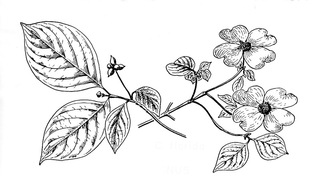 | Back to e-WV
| Back to e-WV
 The West Virginia Encyclopedia
The West Virginia Encyclopedia
 | Back to e-WV
| Back to e-WV
 The West Virginia Encyclopedia
The West Virginia Encyclopedia

Flowering dogwood is a small flowering tree with a short trunk and a spreading crown. Before the leaves appear, four showy white ‘‘petals’’ (actually leaf-like bracts) form a cross-shaped flower that is notched at the tips with red stains. This gives rise to the folklore that Jesus was crucified on a cross of dogwood, so distressing the tree that it never again grew big enough for a cross while blood-stained flowers would always remind people of the crucifixion. Other characteristics are opposite leaves, bright red berries in early autumn, and brilliant red and orange fall foliage. The clusters of berries are a tasty treat for birds, squirrels, and other wildlife.
According to the West Virginia Botanic Garden, “The native flowering dogwoods have white, and sometimes pink flowers. . . . The white part we think of as petals are actually specialized leaf bracts. The real flowers are the little yellowish guys inside.”
Long profuse in West Virginia forests, many dogwoods have been devastated since the 1980s by an anthracnose fungus accidentally introduced into eastern North America in the late 1970s. The fungus causes large brownish leaf spots, spreads to twigs and stems, and eventually kills the tree. Most infected trees die in three to six years. Currently, the survival of the dogwood is in question. The WVU Extension Service offers the following advice to save dogwoods:
1. Catch signs of the disease early. 2. Water during droughts 3. Avoid putting too much mulch against the trunk, over-fertilizing, and over-pruning. 4. Do not dig native trees from the woods and transplant them, which can spread the disease to healthy trees. 5. Prune out dead or dying twigs and limbs during dry weather, as well as water sprouts or suckers on trunks and branches. 6. In the fall, rake and remove fallen leaves, and remove dead leaves on the branches. 7. During extended dry periods, soak the root zone and maintain a two- to three-inch layer of composted mulch over the root zone.
In addition to the flowering dogwood, seven shrubby dogwood species grow in West Virginia. The dwarf cornel grows to only one foot height but also has four showy white petals and clusters of red berries, and creates an excellent landscape ground cover. Other dogwood shrubs have whitish flower clusters and are important for landscaping and wildlife.
Indians chewed dogwood twigs and used the bristle tip as a toothbrush. They also smoked the bark of shrubby dogwoods in their pipes, as part of a smoking mixture called kinnikinnick. Pioneers used the dense wood for shuttles on looms in weaving. Today, flowering dogwood is valued primarily as an ornamental and for carving durable sculptures and crafts.
Written by William N. Grafton
Rahman, Mahfuz. Dogwood anthracnose. WVU Extension Service, April 2021.
Dogwood Family. West Virginia Division of Natural Resources
Smaldone, Erin. Native Spring Blooming Trees. West Virginia Botanic Garden